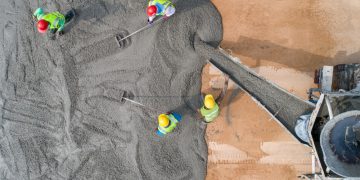A Baltimore contractor is trying out a new concrete formulation that’s designed to cut the material’s embodied carbon by 40% compared to ordinary Portland cement-based concrete, according to the product’s maker.
Baltimore-based Belfast Valley Contractors is using EcoPact on Georgetown University’s 55 H Street 12-story residence hall, the first major Washington, D.C., construction project to use the low-carbon mix. The product will help contribute to the project team’s goal of exceeding LEED-Platinum certification.
The development’s post-tensioned concrete slabs and other components will use approximately 7,000 cubic yards of ECOPact, which is a product of Aggregate Industries, a LafargeHolcim company. The project is slated for completion in 2022.
CFS construction methods make for faster build times, lower overall costs, more versatile, scalable design solutions, and better building performance.Learn More
Introduced by LafargeHolcim in 2020 and sold at a range of low-carbon levels, EcoPact results in in 30% to 100% less carbon emissions compared to standard concrete, according to the company. In addition, where regulatory conditions allow, ECOPact products integrate upcycled construction and demolition materials. The mix is made of cement containing a high portion of what the company calls supplementary cementitious materials.
The formulation is not that much different than working with traditional concrete, said Kevin Riley, project manager for Belfast Valley Contractors and senior project manager on the 55 H Street project. He said that the major difference is a slightly slower set during months that saw temperatures at or below freezing.
“Aside from a change in the mix — the actual proportions of what goes in the mix — we didn’t see a difference in what it looks like or its set times,” he said.
The crew used a trailer pump with two placing booms. By the time the last decks were being poured, 200 to 250 feet of system were necessary. There were no clog problems, nor segregation of the mix. “It pumped beautifully,” he said.
In addition, Riley characterized the long-term strength of the mix as excellent. “Even with the environmental advantages, we’re getting a strength gain as well,” he said.
Characterizing the EcoPact as working, looking and feeling like regular concrete, he said an important advantage is also the reduced carbon footprint the product promises.
“It’s important to recognize that finite nature, because we need to have an industry and careers to sustain us and future generations,” he said.
Baltimore contractor : Future adoption of EcoPact, he feels, will depend on ready availability of Portland cement, of which the Washington, D.C., area has plenty due to the surrounding region’s plentiful limestone. The new product, though, is “something we all need to be cognizant of, look at and push for, if it makes sense on each project given the design team and ownership,” Riley said.
Construct America Magazine | The Home of Construction Industry News




















